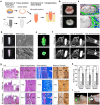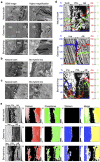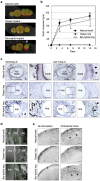Functional tooth restoration by next-generation bio-hybrid implant as a bio-hybrid artificial organ replacement therapy
- PMID: 25116435
- PMCID: PMC4131220
- DOI: 10.1038/srep06044
Functional tooth restoration by next-generation bio-hybrid implant as a bio-hybrid artificial organ replacement therapy
Abstract
Bio-hybrid artificial organs are an attractive concept to restore organ function through precise biological cooperation with surrounding tissues in vivo. However, in bio-hybrid artificial organs, an artificial organ with fibrous connective tissues, including muscles, tendons and ligaments, has not been developed. Here, we have enveloped with embryonic dental follicle tissue around a HA-coated dental implant, and transplanted into the lower first molar region of a murine tooth-loss model. We successfully developed a novel fibrous connected tooth implant using a HA-coated dental implant and dental follicle stem cells as a bio-hybrid organ. This bio-hybrid implant restored physiological functions, including bone remodelling, regeneration of severe bone-defect and responsiveness to noxious stimuli, through regeneration with periodontal tissues, such as periodontal ligament and cementum. Thus, this study represents the potential for a next-generation bio-hybrid implant for tooth loss as a future bio-hybrid artificial organ replacement therapy.
Figures





Similar articles
-
Experimental formation of periodontal structure around titanium implants utilizing bone marrow mesenchymal stem cells: a pilot study.J Oral Implantol. 2009;35(3):106-29. doi: 10.1563/1548-1336-35.3.106. J Oral Implantol. 2009. PMID: 19579523
-
Bio-Root and Implant-Based Restoration as a Tooth Replacement Alternative.J Dent Res. 2016 Jun;95(6):642-9. doi: 10.1177/0022034516639260. Epub 2016 Mar 14. J Dent Res. 2016. PMID: 26976131
-
Functional tooth regeneration using a bioengineered tooth unit as a mature organ replacement regenerative therapy.PLoS One. 2011;6(7):e21531. doi: 10.1371/journal.pone.0021531. Epub 2011 Jul 12. PLoS One. 2011. PMID: 21765896 Free PMC article.
-
Developmental pathways of periodontal tissue regeneration: Developmental diversities of tooth morphogenesis do also map capacity of periodontal tissue regeneration?J Periodontal Res. 2019 Feb;54(1):10-26. doi: 10.1111/jre.12596. Epub 2018 Sep 12. J Periodontal Res. 2019. PMID: 30207395 Review.
-
Biomimetic Properties of Engineered Periodontal Ligament/Cementum in Dental Implants.Contemp Clin Dent. 2020 Oct-Dec;11(4):301-310. doi: 10.4103/ccd.ccd_196_20. Epub 2020 Dec 20. Contemp Clin Dent. 2020. PMID: 33850394 Free PMC article. Review.
Cited by
-
The Neurovascular Properties of Dental Stem Cells and Their Importance in Dental Tissue Engineering.Stem Cells Int. 2016;2016:9762871. doi: 10.1155/2016/9762871. Epub 2016 Sep 5. Stem Cells Int. 2016. PMID: 27688777 Free PMC article. Review.
-
Stem Cells in the Periodontium-Anatomically Related Yet Physiologically Diverse.Eur J Dent. 2024 Feb;18(1):1-13. doi: 10.1055/s-0042-1759487. Epub 2022 Dec 31. Eur J Dent. 2024. PMID: 36588293 Free PMC article.
-
PICN Nanocomposite as Dental CAD/CAM Block Comparable to Human Tooth in Terms of Hardness and Flexural Modulus.Materials (Basel). 2021 Mar 3;14(5):1182. doi: 10.3390/ma14051182. Materials (Basel). 2021. PMID: 33802326 Free PMC article.
-
Tooth Formation: Are the Hardest Tissues of Human Body Hard to Regenerate?Int J Mol Sci. 2020 Jun 4;21(11):4031. doi: 10.3390/ijms21114031. Int J Mol Sci. 2020. PMID: 32512908 Free PMC article. Review.
-
Function of Dental Follicle Progenitor/Stem Cells and Their Potential in Regenerative Medicine: From Mechanisms to Applications.Biomolecules. 2021 Jul 7;11(7):997. doi: 10.3390/biom11070997. Biomolecules. 2021. PMID: 34356621 Free PMC article. Review.
References
-
- Bengel F. M. et al. Effect of sympathetic reinnervation on cardiac performance after heart transplantation. N Engl J Med. 345, 731–738 (2001). - PubMed
-
- Copeland J. G. et al. Cardiac Replacement with a Total Artificial Heart as a Bridge to Transplantation. N Engl J Med. 351, 859–867 (2004). - PubMed
-
- Strain A. J. & Neuberger J. M. A bioartificial liver-state of the art. Science 295, 1005–1009 (2002). - PubMed
-
- Davenport A. et al. A wearable haemodialysis device for patients with end-stage renal failure: a pilot study. Lancet 370, 2005–2010 (2005). - PubMed
Publication types
MeSH terms
Substances
LinkOut - more resources
Full Text Sources
Other Literature Sources

